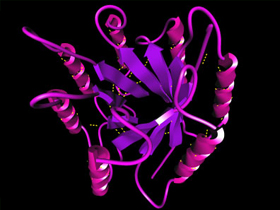 The illustration shows the three-dimensional structure of the myoglobin protein and the peptide groups among the atoms. Such a flawless structure cannot be explained in terms of chance. |
The absence of even a single amino acid in the protein structure or one amino acid changing place, or the addition of one amino acid too many to the chain will make that protein a useless collection of molecules. For that reason, every amino acid must be in exactly the right place and in exactly the right order. The theory of evolution, however, suggests that life came into being by chance. In the face of this regularity, it's in a hopeless position. So extraordinary is this regularity that it cannot possibly be explained in terms of chance. Simple probability calculations easily show that proteins' functional structure can never come into being as the result of coincidences.
For instance, the 288 amino acids of 12 different kinds contained in an average-sized protein molecule, may be set out in 10300 ways. (This is the astronomical figure of 1 followed by 300 zeros.) However, only one of all these sequences can gives rise to the protein. All the remaining sequences are meaningless strings of amino acids that are either useless, or may even be harmful.
 The three-dimensional structure of a protein |
Moreover, a protein consisting of 288 amino acids can be regarded as a rather humble structure, compared with giant proteins consisting of thousands of amino acids found in many living things. When the same probability calculations are applied to these giant molecules, even the word impossible fails to do justice to the situation.
Moving up one rung in the development of living things, we see that a protein on its own means nothing. Mycoplasma hominis H39, one of the smallest known bacteria, has been observed to possess 600 kinds of proteins. Therefore, we need to square the probability calculation we carried out on just one protein by 600. The figure that emerges goes way beyond the concept of merely impossible.
Nor can evolutionists object to these figures. They also accept that the chances of a single protein coming into being by chance are as slim as those of "a monkey writing the history of mankind by randomly striking the keys of a typewriter." 191 Yet rather than accept the true explanation-creation-they prefer this utter impossibility.
Many evolutionists admit this. The evolutionist scientist Harold Bloom, for instance, says, "The spontaneous formation of a polypeptide of the size of the smallest known proteins seems beyond all probability."192
Evolutionists claim that molecular evolution took a very long time and that this time frame made the impossible possible. But no matter how much time is allowed, it is still impossible for amino acids to randomly give rise to proteins. In his book Essentials of Earth History, the American geologist William Stokes admits that "it would not occur during billions of years on billions of planets, each covered by a blanket of concentrated watery solution of the necessary amino acids."193
When one examines the vast number of possible structures that could result from a simple random combination of amino acids in an evaporating primordial pond, it is mind-boggling to believe that life could have originated in this way. It is more plausible that a Great Builder with a master plan would be required for such a task.194
191. Prof. Dr. Ali Demirsoy, Kalıtım ve Evrim ("Heredity and Evolution"), p. 61.
192. W. R. Bird, The Origin of Species Revisited, Nashville: Thomas Nelson Co., 1991, p. 304.
193. Ibid., p.305.
194. J. D. Thomas, Evolution and Faith, Abilene, TX: ACU Press, , 1988, pp. 81-82.


